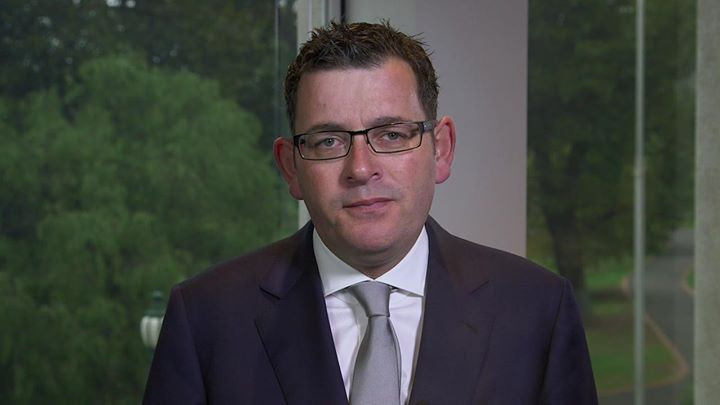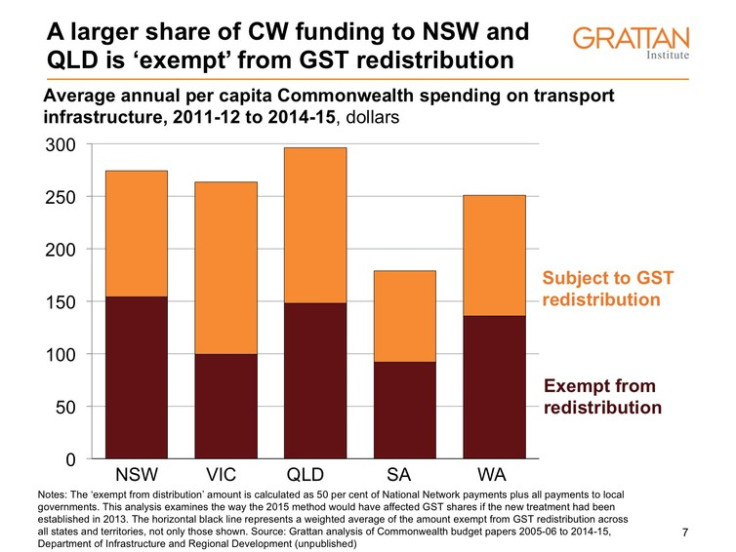Analysis: Flawed GST system skews state transport projects

Commitments by the Commonwealth Government to fund transport infrastructure in the states are invariably announced with fanfare, as state transport ministers celebrate the triumph of securing federal money for their project. It seems such a great win for a state: a big new road or rail link, and someone else paying for it.
On the flipside, state governments are the first to point out the injustice if their share is less than average, as Victoria did in the lead up to the recent COAG meeting.
But all this drama is often little more than pantomime. When the Commonwealth Government gives money to the states in this way, it makes for a good ministerial press conference, but not much clarity around the true benefit for a given state. In reality what the Commonwealth giveth, it mostly taketh away again, via the GST distribution.
How GST distributions work
Each year, the Commonwealth Grants Commission has the job of determining a fair way to distribute GST revenue between the states and territories. They start by determining each state’s fair share, based on their unique needs and abilities to raise their own revenue. They then take into account funding the states have already received from the Commonwealth in the preceding three years. This money is then effectively subtracted from the amount of GST they receive.
The process makes something of a mockery of states’ efforts to secure federal contributions towards their infrastructure projects, since the bulk of the federal funding will effectively be clawed back and distributed among all states over the following three years.
However, not all Commonwealth grants are equal. If funding is for a transport project on the National Land Transport Network, 50% of the funds are quarantined from GST redistribution. That is, half of the money is genuinely additional, and of long-term advantage to the state. The rationale for this is that Commonwealth investment in the National Network creates links of importance to the national economy.
In practice, though, the process by which links are added to the Network can be somewhat arbitrary and hard to fathom. Some changes to the Network seem to be more the result of deals between governments than genuine consideration of the national importance of infrastructure.
For example, the section of the Princes Highway between Geelong and Colac doesn’t meet the required legislative condition of connecting two important hubs, whether capital cities or major economic centres, yet it was added to the Network in 2009 as part of a deal for federal funding. The Melbourne Metro tunnel, on the other hand, is not on the Network. So the Victorian government would be better off seeking Commonwealth money for the Colac road than for the Metro tunnel. It would be hard to argue that the road to Colac, scenic though it is, has greater national importance.
This dual system, in which half of certain payments are quarantined from the GST distribution process, has not been in place for long – it was introduced in 2010 for roads and 2015 for rail. As the new dual system is not fully mature, it has yet to fully factor into states’ negotiations.
The end result is a convoluted system where few – including politicians – can appreciate the real impact of decisions.
The chart below shows the actual spending on transport infrastructure by the Commonwealth over the four years to 2014-15, and how the recently introduced GST distribution arrangements would operate on such spending once the arrangements are fully mature, in 2017-18.

Total Commonwealth funding was skewed in favour of New South Wales and Queensland, but what really matters is the fact that payments exempt from GST redistribution – that is, genuine transfers to the states – advantaged these states even more. Under these arrangements, Victoria’s below-average receipt of funds for National Network projects would cost the state around A$190 million a year, and South Australia’s shortfall would be around A$67 million a year.
The alternative
It would be much better – simpler, and more transparent – to treat Commonwealth transport infrastructure payments to the states consistently, whether by making all the decisions stick, or letting the GST distribution wash all the funding variation away.
Allowing the payments to be fully washed out by GST distribution makes sense if Commonwealth decisions are biased by electoral rather than economic or social criteria. But even if this is the case, this is surely a defeatist way to deal with the problem of equitable treatment among the states and territories.
If we accept that the Commonwealth has a rightful role in supporting transport infrastructure for economic growth of the nation as a whole, a much better approach would be to improve the basis of the Commonwealth’s decisions, and then commit national funding to the projects it approves. Transport money should be exempted from the GST allocation pool so that it sticks where it hits, in whichever state, and is not be cancelled out by a rule-based process executed by the Grants Commission.
The treasurer should give the Grants Commission an explicit instruction to exclude transport infrastructure payments from being unravelled by future GST distributions. Such a change would give the scripted drama of funding announcements for state projects an injection of reality, improving transparency, and empowering the Commonwealth to make genuine nation-building decisions, rather than working around the technicalities of a flawed system.
Marion Terrill, Transport Program Director, Grattan Institute and Owain Emslie, Associate, Grattan Institute
This article was originally published on The Conversation. Read the original article.





















